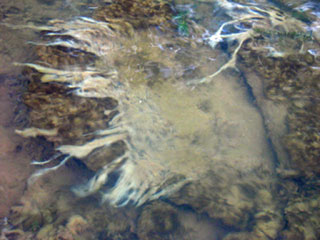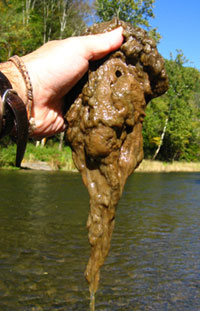State Agencies Issue Alert to Contain Invasive Species in Youghiogheny
3 min read
Photo - Tim Daley, PA DEP

HARRISBURG – With the recent discovery that the invasive aquatic alga known as didymo, or “rock snot,” has been confirmed in the Youghiogheny River, Fayette County, the Pennsylvania Fish and Boat Commission and Department of Conservation and Natural Resources are reminding anglers and boaters that cleaning their gear is the easiest, most effective means of preventing the alga from spreading to other waters.
During the past two months, state officials have documented didymo blooms in the Youghiogheny River at Ohiopyle State Park, in the Delaware River as far south as Bucks County, and in Dyberry Creek in Wayne County.
“We may not be able to eliminate didymo from an infected waterway, but we can do our best to slow its spread and to prevent it from spreading to other waters,” said Bob Morgan, the PFBC’s biologist who studies aquatic invasive species (AIS). “Didymo cells can easily be carried downstream and can be picked up by any items or equipment contacting the infected water, including fishing tackle, waders, recreational equipment, and boats and trailers. It takes only one live didymo cell to start a new colony of the alga. We urge anglers and boaters to ‘Clean Your Gear!’ before leaving a water body and entering another one.”
“The Youghiogheny River at Ohiopyle State Park provides some of the best white- water boating and water based recreation in the Eastern United States,” said Bureau of State Parks Director John Norbeck. “The discovery of didymo has no immediate impact to the visitor experience on or along the ‘Yough.’ Didymo is not considered a significant risk to human health.”

Norbeck said the park is working with the Fish and Boat Commission and Department of Environmental Protection to monitor and survey the Youghiogheny River.
“The park encourages all boaters, fishermen and visitors to be vigilant and avoid spreading didymo into other rivers and streams by properly washing all gear, equipment and watercraft used in the ‘Yough,’” Norbeck said. “The Lower and Middle ‘Yough’ are open for all recreational uses including white-water boating and fishing.”
The PFBC recommends that anglers allow exposed equipment to completely dry before entering new waters. After equipment is dry to the touch, allow to dry another 48 hours, the commission suggests. Thick and dense material — life jackets and felt-soled wading gear — will hold moisture longer, take longer to dry, and can be more difficult to clean. Soaking equipment in hot water containing dishwashing detergent (2 cups detergent/2.5 gallons of water) for 20 minutes or more also will kill didymo and some other AIS.
Cleaning boats and equipment with hot water (maintained at 140 F) by pressure washing or soaking is another effective method. If hot water is not available, a commercial hot-water car wash also makes a good location to wash boats, motors and trailers. At the other end of the temperature range, freezing items solid for at least 24 hours is effective. If cleaning, drying or freezing is not practical, please restrict the equipment’s use to a single waterway. For more details on how to stop the spread of didymo, visit http://www.fishandboat.com/water/habitat/ans/didymo/faq_didymo.htm. For more information on how to clean your gear, visit http://fishandboat.com/cleanyourgear.htm.
The PFBC and DCNR are coordinating to identify appropriate next steps, including further sampling of waterways to determine if there are additional areas with didymo. Didymo is not a public health hazard, but it can cause ecological damage by smothering other organisms which also live on the riverbed and support the food web for the resident fish community. It’s been called “rock snot” because of its appearance but when squeezed “‘dry” the alga, which is generally tan to beige in color, actually has the feel of moist cotton or wool. Its scientific name is Didymosphenia geminata.